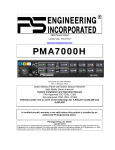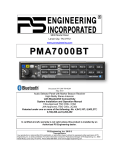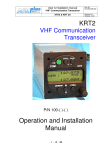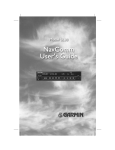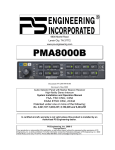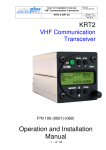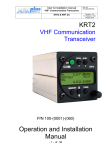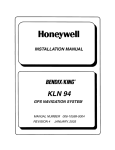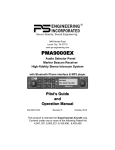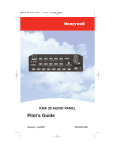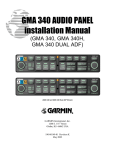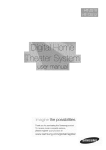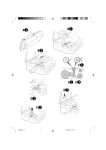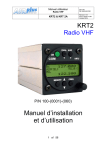Download PAR200 Installation Manual
Transcript
9800 Martel Road Lenoir City, TN 37772 www.ps-engineering.com P A R 2 0 0A With Trig Avionics TY91(L) Document P/N 200-228-0200 July 2014 Audio Selector Panel with VHF Communications Transceiver and High-fidelity Stereo Intercom System Installation and Operation Manual Patented under one or more of the following; No. 4,941,187; 5,903,227; 6,160,496 and 6,493,450 FAA-TSO C139, TSO C169a (PARTIAL) The product warranty is not valid unless this product is installed by an Authorized PS Engineering dealer. PS Engineering, Inc. 2014 © Copyright Notice Any reproduction or retransmittal of this publication, or any portion thereof, without the expressed written permission of PS Engineering, Inc. is strictly prohibited. For further information contact the Publications Manager at PS Engineering, Inc., 9800 Martel Road, Lenoir City, TN 37772. Phone (865) 988-9800, email [email protected]. Table of Contents Section I – GENERAL INFORMATION................................. 1-1 1.1 1.2 1.3 1.4 INTRODUCTION............................................................................................................................ 1-1 SCOPE .............................................................................................................................................. 1-1 EQUIPMENT DESCRIPTION....................................................................................................... 1-1 APPROVAL BASIS — FAA TSO................................................................................................... 1-2 1.1.1 PAR200A ......................................................................................................................... 1-2 1.1.2 TRIG TY91-SERIES: .......................................................................................................... 1-2 1.5 1.6 1.7 1.8 SPECIFICATIONS.......................................................................................................................... 1-2 EQUIPMENT SUPPLIED............................................................................................................... 1-4 EQUIPMENT REQUIRED BUT NOT SUPPLIED ...................................................................... 1-4 LICENSE REQUIREMENTS......................................................................................................... 1-4 2.1 GENERAL INFORMATION.......................................................................................................... 2-1 Section II - INSTALLATION ......................................... 2-1 2.1.1 SCOPE.............................................................................................................................. 2-1 2.1.2 CERTIFICATION REQUIREMENTS ...................................................................................... 2-1 2.2 2.3 2.3.1 2.3.2 2.3.3 2.3.4 2.4 UNPACKING AND PRELIMINARY INSPECTION .................................................................................. 2-1 EQUIPMENT INSTALLATION PROCEDURES ....................................................................................... 2-1 COOLING REQUIREMENTS ................................................................................................ 2-1 MOUNTING REQUIREMENTS ............................................................................................. 2-1 TRIG TY91 MOUNTING REQUIREMENTS ........................................................................... 2-2 AUDIO PANEL MOUNTING RACK INSTALLATION ............................................................. 2-2 CABLE HARNESS WIRING ................................................................................................................. 2-2 2.4.1 NOISE ................................................................................................................................ 2-2 2.4.2 AUDIO PANEL TRAY AND CONNECTOR ASSEMBLY ......................................................... 2-3 2.4.3 AUDIO PANEL INTERFACE ................................................................................................ 2-3 2.5 2.5.1 2.5.2 2.5.3 2.5.4 2.5.5 2.6 2.6.1 2.6.2 2.6.3 2.6.4 2.6.5 2.7 TY91 VHF COM INTERFACE........................................................................................................... 2-4 TY91 CONNECTOR (TRIG TY91(L) -05 ONLY)................................................................. 2-4 INTERFACING THE TY91(L) AS SINGLE, COM 1 OR COM 2 ............................................ 2-4 ANTENNA CABLE .............................................................................................................. 2-4 TY91 TNC ANTENNA CONNECTION ................................................................................. 2-5 VHF COMMUNICATIONS ANTENNA INSTALLATION......................................................... 2-5 TELEPHONE (DUPLEX) FUNCTION FOR BLUETOOTH ® CAPABLE CELL PHONES ...................... 2-6 PAIRING SEPARATE MUSIC AND TELEPHONE DEVICES...................................................... 2-6 TELEPHONE SIDETONE ...................................................................................................... 2-7 "SWAP" MODE .................................................................................................................. 2-7 BACKLIGHTING ................................................................................................................. 2-7 UNSWITCHED INPUTS ........................................................................................................ 2-7 INTERCOM WIRING ............................................................................................................................ 2-8 2.7.1 MUSIC INPUTS................................................................................................................... 2-8 2.7.2 MUSIC MUTING ................................................................................................................. 2-8 2.8 DISASSEMBLY ...................................................................................ERROR! BOOKMARK NOT DEFINED. 2.9 MICROPHONE GAIN REDUCTION ................................................................................................... 2-10 2.10 COMMUNICATIONS ANTENNA INSTALLATION NOTES ................................................................. 2-11 2.10.1 ANTENNA LOCATION .................................................................................................... 2-11 2.11 TY91(L) ADJUSTMENTS ................................................................................................................ 2-11 2.11.1 RADIO SIDETONE & RADIO SQUELCH ADJUSTMENT ................................................... 2-11 2.11.2 RADIO FREQUENCY SPACING, 25 KHZ OR 8.33 KHZ..................................................... 2-11 2.14............................................................................................................................................................ 2-12 2.13 POST INSTALLATION CHECKOUT ................................................................................................. 2-14 2.14 UNIT INSTALLATION...................................................................................................................... 2-14 2.15 OPERATIONAL CHECKOUT ........................................................................................................... 2-14 PS Engineering Inc. ® PAR200A Audio Selector Panel, COM radio Controller and Intercom System Installation and Operator’s Manual 2.15.1 TY91 CHECKOUT.......................................................................................................... 2-14 2.15.2 TELEPHONE CHECKOUT ............................................................................................ 2-15 2.16 FINAL INSPECTION ........................................................................................................................ 2-15 3.1 3.2 SCOPE .............................................................................................................................................. 3-1 POWER AND FAIL SAFE (1)................................................................................................................ 3-1 Section III OPERATION ............................................. 3-1 3.2.1 TY91(L) RADIO POWER (AS COM 1 ONLY) ..................................................................... 3-1 3.2.2 ICS AND RADIO VOLUME CONTROLS (1) ......................................................................... 3-1 3.3 3.4 3.5 3.6 3.7 3.7.1 3.7.2 3.7.3 3.7.4 3.8 COMMUNICATIONS TRANSMIT (XMT) SELECTION (2).................................................................... 3-2 COM AUDIO SELECTOR (3).............................................................................................................. 3-2 NAVAID AUDIO SELECTION (4).......................................................................................................... 3-2 COCKPIT SPEAKER (10) .................................................................................................................... 3-2 VHF TRANSCEIVER CONTROL (5) .................................................................................................... 3-3 FREQUENCY SELECTION (6).............................................................................................. 3-3 RADIO SQUELCH ............................................................................................................... 3-4 MONITOR MODE (WHEN PAR200A IS COM 1 OR STAND ALONE ONLY) ......................... 3-4 TUNING 8.33 KHZ CHANNEL SPACING.............................................................................. 3-5 INTERCOM OPERATION (8) ............................................................................................................... 3-6 3.8.1 INTELLIVOX® VOX-SQUELCH .......................................................................................... 3-6 3.8.2 MONO HEADSETS IN STEREO INSTALLATION ................................................................... 3-7 3.8.3 INTERCOM MODES (8) ...................................................................................................... 3-7 3.9 BLUETOOTH OPERATION................................................................................................................... 3-7 3.9.1 BLUETOOTH TELEPHONE CONNECTION ........................................................................... 3-7 3.9.2 TELEPHONE (TEL) OPERATION ........................................................................................ 3-7 3.10 MUSIC INPUTS ................................................................................................................................. 3-8 3.10.1 MUSIC MUTING (9) ......................................................................................................... 3-9 Section IV – Warranty and Service ..................................... 4-1 4.1 4.2 WARRANTY ........................................................................................................................................ 4-1 FACTORY SERVICE ............................................................................................................................ 4-1 Appendix A – External PTT Hook Up A Appendix B – PAR200A Installation Drawings ............................................................. b 6.1 TY91 RADIO INSTALLATION DRAWINGS ............................................................................................B Appendix C – J1 Connector Interconnect....................................C Appendix D – J2 Connector Interconnect................................... D Appendix E – Instructions for FAA Form 337 and continuing airworthiness ........ E 9.1 9.2 9.3 INSTRUCTIONS FOR FAA FORM 337, AUDIO PANELS .........................................................................E INSTRUCTIONS FOR CONTINUING AIRWORTHINESS, AUDIO SYSTEM ................................................E ICA FOR TRIG TY91/92 RADIO:..........................................................................................................E Appendix F – RTCA DO160G Environmental Qualification Form............................... F Rev 0 Date June 2014 200-228-0200 Change Release of PAR200A version Page ii June 2014 PS Engineering Inc. ® PAR200A Audio Selector Panel, COM radio Controller and Intercom System Installation and Operator’s Manual Section I – GENERAL INFORMATION 1.1 INTRODUCTION The PAR200A represents another evolutionary step in cockpit audio control and intercommunications utility. Using our patented IntelliVox® design and pilot programmable configurations, this marks the next level of audio control. The unit is designed for outstanding ergonomics and visually defined mode annunciation and selection. Before installing and/or using this product, please read this manual completely. This will ensure that you will take full advantage of all the advanced features in the PAR200A. 1.2 SCOPE This manual provides detailed installation and operation instructions for the PS Engineering PAR200Aseries of Audio Selector Panel/Intercom Systems. This includes the following units: Model Description PAR200A TY91(L) 00882-00-05 1.3 Stereo Audio Selector Panel with control for VHF Communications radio. Includes stereo intercom, with Bluetooth Interface VHF Communications Transceiver PS Engineering Part Number 050-228-0200 050-228-8744 EQUIPMENT DESCRIPTION The PAR200A is a state-of-the-art audio isolation amplifier and audio selector that contains an automatic voice activated (VOX) intercom system and serial data control/indication for a Trig VHF communications receiver. It can switch two transceivers (Com 1, Com 2) and two receivers (Nav 1, Nav 2). A Bluetooth ® TELEPHONE feature allows the PAR200A to interface the aircraft headset(s) and Bluetooth enabled cellular devices. Warning: Use of non-aviation approved cellular telephone equipment may be prohibited by regulation. PS Engineering is not responsible for unauthorized airborne use of cellular telephones. For airborne use, the PAR200A must be interfaced with an approved system. There are four unswitched inputs, available for traffic or EGPWS, autopilot disconnect tones, and/or radar altimeter warning. Pushbutton switches select one of the communication transceivers for the pilot and copilot position, and allows radio transmission. In "Split Mode" the PAR200A has the ability to allow the pilot to transmit on Com 1 while the copilot can transmit on Com 2. A fail-safe mode connects the pilot headphone and microphone to COM 1 if power is removed for any reason, or if the power switch is placed in the Off (Fail-safe) position. Unswitched input #1 is also provided to the pilot headphone in fail-safe A four-station voice activated (VOX) intercom is included in the PAR200A. This system has PS Engineering’s patented IntelliVox® circuitry that eliminates manual adjustments. The intercom system incorporates pilot isolate, all and crew modes, two independent stereo music inputs with "SoftMute™". Volume control is through the concentric front panel knobs and a pushbutton intercom mode switch. The small knob controls the intercom volume level for the all headsets, while the large knob controls the VHF Com radio volume. Intercom squelch is automatic. A concentric rotary data input knob on the right side of the unit controls the TY91L VHF COM radio frequency selection. 200-228-0200 Page 1-1 June 2014 PS Engineering Inc. ® PAR200A Audio Selector Panel, COM radio Controller and Intercom System Installation and Operator’s Manual 1.4 APPROVAL BASIS — FAA TSO 1.1.1 PAR200A The PAR200A Intercom is FAA approved under TSO C139 (Aircraft Audio Systems and Equipment) and contains partial elements of TSO C169a (VHF Radio Communications Transceiver Equipment Operating Within Radio Frequency Range 117.975 To 137.000 Megahertz). The partial TSO applies to C169a, because the PAR200A unit provides control and display only for the TY91-series of VHF communications equipment. The PAR200A-series Audio Selector Panels are FAA approved under TSO C139 (Aircraft Audio Systems and Equipment). The VHF Communication Transceiver portion of the PAR200A is TSO approval under TSO C169a. The audio system complies with relevant portions of ED-14C/DO-160G (Environmental Conditions and Test Procedures for Airborne Equipment), DO-254, (Design Assurance Guidance for Airborne Electronic Hardware) and ED-18/DO-214 (Audio Systems Characteristics and Minimum Operational Performance Standards for Aircraft Audio Systems). NOTE: The conditions and tests for TSO approval of this article are minimum performance standards. Those installing this article, on or in a specific type or class of aircraft, must determine that the aircraft installation conditions are within the TSO standards. The article may be installed only following 14 CFR Part 43 or the applicable airworthiness requirements. 1.1.2 Trig TY91-Series: The VHF Communication Radio (Trig Avionics TY91L)is EASA and FAA-approved under ETSO 210.10042695, Rev, B or Subsequent Revision, under 2C169a Class C, E, H1, H2, 4, 6, ETSO 2C128, TSO C169a Class C, E, 4, 6, TSO C128a TSO-C169a, ETSO 2C169a Class C, E, H1, H2, 4, 6, ETSO 2C128, TSO C169a Class C, E, 4, 6, TSO C128a EUROCAE ED-23C, EUROCAE ED-67, EUROCAE ED-14F (RTCA DO-160F), RTCA DO-186B, RTCA DO-207 ED-12B (RTCA DO-178B) Level B DO-254 Level C FCC Identification VZI00882 Applicable documents EUROCAE ED-23C, EUROCAE ED-67, EUROCAE ED-14F (RTCA DO-160F), RTCA DO-186B, RTCA Software ED-12B (RTCA DO-178B) Level B Hardware DO-254 Level C Operation is subject to the following conditions: This device may not cause harmful interference. This device must accept any interference received, including interference that may cause undesired operation. 1.5 SPECIFICATIONS Audio Selector/Intercom Communications Transceiver Environmental Qualification DO-160G Operating Temperature Range: Altitude: WEIGHT PAR200A Unit Rack with connectors Dimensions FAA TSO C139 FAA TSO-C169a (PARTIAL) A1C1BAESRXXXXXXZ B(XX)ABATTBXXA2E2 XXX -20º C to 55ºC , short term -40°C to +70°C Up to 35,000 feet in an non-pressurized area 1.1 lb. (0..49 kg) 0.51 lb. (0.24 kg) Height: 1.3 in. (3.3 cm) Width: 6.25 in. (16.9 cm) Depth behind panel 7.15 in. (18.16 cm) AUDIO PANEL POWER REQUIREMENTS (Including Internal Lighting): Voltage: 11-33 VDC Maximum Current: 2.5 Amp (Externally protected by a 3A pull-type breaker) 200-228-0200 Page 1-2 June 2014 PS Engineering Inc. ® PAR200A Audio Selector Panel, COM radio Controller and Intercom System Installation and Operator’s Manual Audio Selector Specifications Audio selector panel input impedance: 510 Input Isolation: -60 dB (min.) Receiver Inputs: 4 (Com 1, Com 2, Nav 1, Nav 2) Unswitched Inputs: 4 Transmitter Selections: 3 (Com 1, Com 2, Com1/2) Headphone Impedance: 150 – 1000 Headphone Output: 38 mW each headset, no clipping <1% THD typical into 150 Speaker Output (into 4 ) with no clipping 3 Watts (min.) 14 VDC: 10 Watts (min.) 28 VDC: Microphone Impedance: 150 - 600 Intercom Specifications Intercom Positions: Music Inputs: Music Muting: Distortion: Mic Freq. Response, 3 dB: Music Freq. Response, 3 dB: 4 places (with individual IntelliVox® circuits) 2, (Independent, Stereo) >-30 dB "Soft Mute" when Com or intercom active. <1% THD @ 38 mW into 150 300 Hz - 6000 Hz 10 Hz – 26 kHz TY91L VHF Transceiver Specifications Radio Type Channels (Transmit & receive) Frequency Selection Frequency Display Frequency control Power consumption Receive (no signal) Transmit Input Voltage Power output Receiver sensitivity Data Interface Headset volume output Temperature range Stability Dimensions Weight FCC ID: 200-228-0200 Amplitude Modulation (AM) Aircraft Transceiver 760 channels, 25KHz spacing 2280 channels, 8.33 kHz spacing 118.000 – 136.992MHz On PAR200A Audio Panel Alpha/numeric LCD display (with backlighting) on PAR200A PLL frequency synthesis, which is microprocessor controlled Memory is store in non-volatile EPROM 2.8W @ 14VDC 3.2A 11-33 VDC 5A Circuit Breaker. 5 watts (nominal) VSWR Tolerance < 2:1 for best operation (5:1 without damage) -6dB SINAD @ 5µV (1KHz audio with 70% modulation) RS232 Nominal 100 milliwatts output to 600 Ω -20 to +70 degrees Celsius < +/- 4.00 ppm W-2.5” x H-1.9” x D6.3” (plus 1.5” for harness) W66mm xH-48mm x D-160 (plus 35mm for harness) .77 lbs .350 kg VZI00882 Page 1-3 June 2014 PS Engineering Inc. ® PAR200A Audio Selector Panel, COM radio Controller and Intercom System Installation and Operator’s Manual 1.6 EQUIPMENT SUPPLIED 1 ea. of the following items: Model Description PAR200A TY91(L) PS Part Number PAR200A Audio Panel with intercom and radio function control VHF Communications Transceiver Trig P/N 050-228-0200 050-228-8744 00882-00-05 Installation Kit: 250-890-0000, containing: Quantity Part Number PAR200A installation rack assembly PAR200A Rack back plate Description 1 1 430-890-0040 430-890-0050 44-pin connector kit Backshell, connector Backshell Retainer 4 40 X 7/16 screw w/nylon patch 4 40 X 3/8 screw w/lock washer 4 40 X 1/8 screw w/lock washer Solder Lug Cable Clamp #6-32 x ½” Flat head Philips screw #6-32 Clip Nut 2 2 2 4 4 2 2 1 6 6 120-891-2045625-025-2465 431-891-0100 475-440-0007 475-440-1038 475-440-0001 475-009-0001 625-001-0002 475-632-0012 475-630-0002 Quantity Part Number 1 1 2 25 1 425-025-0010 625-025-0001 475-002-0002 425-020-5090 425-400-1223 TY91 Installation Kit 250-228-0200, Containing: Description DB 25 Connector , Crimp type DB 25 Connector hood DB 25 Thumb Screws 4-40 x 1.94 Crimp female sockets TNC Crimp Connector 1.7 EQUIPMENT REQUIRED BUT NOT SUPPLIED a. b. c. d. e. f. g. h. i. 1.8 Circuit Breaker: 1 ea; 3 amp PULL TYPE REQUIRED for PAR200A Circuit Breaker: 1 ea; 5 amp PULL TYPE REQUIRED for transceiver power (to TY91) Headphone Jacks (up to 4 Stereo, as Required) Microphone Jacks (up to 4 as Required) Headphones, 150 (Stereo), up to 4 as required Microphones, up to 4 as required VHF Communication antenna 118-137 MHz, VSWR <2:1 (FAA-TSO approved is recommended) Mounting hardware for TY91, as appropriate Interconnect Wiring, coaxial cable (RG400 or RG142B or equivalent) LICENSE REQUIREMENTS In some localities other than the United States, an Aircraft Radio Station license may be required. In the United States, you do not need a license to operate a two-way VHF radio aboard aircraft operating domestically. Aircraft operating domestically do not land in a foreign country or communicate via radio with foreign ground stations. Flying in international or foreign airspace is permitted, so long as the previous conditions are met. If you travel to a foreign destination, however, (e.g., Canada, Mexico, Bahamas, British Virgin Islands) a license is required. Visit http://wireless.fcc.gov for more information. 200-228-0200 Page 1-4 June 2014 PS Engineering Inc. ® PAR200A Audio Selector Panel, COM radio Controller and Intercom System Installation and Operator’s Manual Section II - INSTALLATION 2.1 2.1.1 GENERAL INFORMATION SCOPE This section provides detailed installation and interconnection instructions for the PS Engineering PAR200A Audio Selector Panel/Intercom/ with VHF communication radio controls. Please read this manual carefully before beginning any installation to prevent damage and post-installation problems. Installation of this equipment requires special tools and knowledge. 2.1.2 Certification Requirements NOTE The PAR200A Intercom is FAA approved under TSO C139 (Aircraft Audio Systems and Equipment) and contains partial elements of TSO C169a (VHF Radio Communications Transceiver Equipment Operating Within Radio Frequency Range 117.975 To 137.000 Megahertz). The partial TSO applies to C169a, because the PAR200A unit provides control and display only for the TY91-series of VHF communications equipment. The conditions and tests for TSO approval of this article are minimum performance standards. Those installing this article, on or in a specific type or class of aircraft, must determine that the aircraft installation conditions are within the TSO standards. The article may be installed only following 14 CFR Part 43 or the applicable airworthiness requirements. See FAA AC 20-41A for information regarding substitute TSO Aircraft Equipment. 2.2 Unpacking and Preliminary Inspection Use care when unpacking the equipment. Inspect the units and parts supplied for visible signs of shipping damage. Examine the unit for loose or broken buttons, bent knobs, etc. Verify the correct quantity of components supplied with the list in Section 1.6 (B). If any claim is to be made, save the shipping material and contact the freight carrier. Do NOT return units damaged in shipping to PS Engineering. If the unit or accessories show any sign of external shipping damage, contact PS Engineering to arrange for a replacement. Under no circumstances attempt to install a damaged unit in an aircraft. Equipment returned to PS Engineering for any other reason should be shipped in the original PS Engineering packaging, or other UPS approved packaging. 2.3 2.3.1 Equipment Installation Procedures Cooling Requirements Forced air-cooling of the PAR200A is not required. However, the units should be kept away from heat producing sources (i.e. defrost or heater ducts, dropping resistors, heat producing avionics) without adequate cooling air provided. 2.3.2 Mounting Requirements The PAR200A must be rigidly mounted to the instrument panel of the aircraft structure, within view and reach of the pilot position(s). The unit may be mounted in any area where adequate clearance for the unit and associated wiring bundle exist. To prevent noise, avoid installing the unit close to high current devices or systems with high-voltage pulse type outputs, such as DME or transponders. Avoid running the interconnecting bundles near any high current wires. 200-228-0200 Page 2-1 June 2014 PS Engineering Inc. ® PAR200A Audio Selector Panel, COM radio Controller and Intercom System Installation and Operator’s Manual 2.3.3 Trig TY91 mounting requirements The TY91 remote VHF Communications radio is mounted to the aircraft structure with 4 ea #6-32 (not supplied) screws through the mounting flange. Guidance can be found in AC 43.13-2B, Chapter 2. Figure 2-1 TY91 VHF Transceiver (Remote Mount) 2.3.4 Audio Panel Mounting Rack Installation Remove the audio panel from the mounting tray by unscrewing the 3/32" hex-head screw that is in the center of the unit. Use caution to avoid hitting the photo-detector lens. Carefully slide the unit free of the tray. Set the unit aside in a safe location until needed. Install the tray using six clip nuts (475-630-0002), and six FHP 6-32 x ½" screws (475-632-0012). The audio selector panel must be supported at front and rear of the mounting tray. 2.4 Cable Harness Wiring Referring to the appropriate Appendix, assemble a wiring harness as required for the installation. All wires must be MIL-SPEC in accordance with current regulations. Two- and three-conductor shielded wire must be used where indicated, and be MIL-C-27500 or equivalent specification. Proper stripping, shielding and soldering technique must be used at all times. It is imperative that correct wire be used. Refer to FAA Advisory Circular 43.13-2B for more information. Failure to use correct techniques may result in improper operation, electrical noise or unit failure. Damage caused by improper installation will void the PS Engineering warranty. Custom factory wiring harnesses can be purchased from PS Engineering, call 865-988-9800 for details or visit our website http://www.ps-engineering.com/downloads.shtml and click on Work Sheet for the appropriate product. 2.4.1 Noise Due to the variety and the high power of radio equipment often found in today's general aviation aircraft, there is a potential for both radiated and conducted noise interference. The PAR200A power supply is specifically designed to reduce conducted electrical noise on the aircraft power bus by at least 50dB. Although this is a large amount of attenuation, it may not eliminate all noise, particularly if the amplitude of noise is very high. There must be at least 13.8 VDC present at the connector, J2 pins 8 & 9, of the PAR200A for the power supply to work in its designed regulation. Otherwise, it cannot adequately attenuate power line noise. Shielding can reduce or prevent radiated noise (i.e., beacon, electric gyros, switching power supplies, etc.) However, installation combinations can occur where interference is possible. The PAR200A was designed in a RFI hardened chassis and has internal Electromagnetic Interference (EMI) filters on all inputs and outputs. Ground loop noise occurs when there are two or more ground paths for the same signal (i.e., airframe and ground return wire). Large cyclic loads such as strobes, inverters, etc., can inject noise signals onto the airframe that are detected by the audio system. Follow the wiring diagram very carefully to help ensure a min- 200-228-0200 Page 2-2 June 2014 PS Engineering Inc. ® PAR200A Audio Selector Panel, COM radio Controller and Intercom System Installation and Operator’s Manual imum of ground loop potential. Use only Mil Spec shielded wires (MIL-C-275000, or better). Under no circumstances combine a microphone and headphone wiring into the same shielded bundle. Always use a 2- or 3-conductor, shield wire as shown on the installation-wiring diagram. The shields can be daisy-chained together, and then connected to the ground lugs mounted on the center of the back plate. Radiated signals can be a factor when low level microphone signals are "bundled" with current carrying power wires. Keep these cables physically separated. It is very important that you use insulated washers to isolate the ground return path from the airframe to all headphone and microphone jacks. 2.4.1.1 Music Inputs and Noise PAR200A units utilize differential music inputs to help prevent noise from entering the music system. This feature is usually transparent to the installer, however, it is important that the appropriate music signal and ground connections are made directly to the dedicated music signal and ground inputs on the PAR200A. The power for IFE and audio panel should be a common bus. If a music jack is installed for Music 1 or 2, we strongly recommend isolating the jack from airframe ground, by using an insulated mounting plate. NOTE Adding a high-performance audio control system, particularly in conjunction with high-performance active noise canceling headsets, cannot improve on older avionics that were designed for cabin-speaker use. PS Engineering makes no claim that the audio panel will provide a noise-free audio quality under all installation conditions, particularly with older avionics. 2.4.2 Audio Panel Tray and Connector Assembly The rack connectors mate with two 44-pin connectors in the PAR200A. The connectors are a sub-miniature crimp-type, and require the use a hand crimp tool, from table below (or equiv.). The connectors are mounted to the tray back plate with #4-40 screws (475-440-1038), from the inside of the tray and the mounting block, 431-891-0100. Ensure that proper strain relief and chafing precautions are made during wiring and installation, using the cable clamp (625-001-0002). Manufacturer Crimping Tool Positioner Extraction tool AMP 601966-1 601966-6 91067-1 Daniels AFM8 K42 M24308-1 ITT-Cannon 995-0001-584 995-0001-739 91067-1 Table 2-1 PAR200A Connector Pin crimping tools Manufacturer Mil-Spec Daniels Crimping Tool M22520/2-01 AFM8 Positioner M22520/2-08 K13-2 Extraction tool Table 2-2 TY91 Connector Crimping tools 2.4.3 Audio Panel interface The PAR200A is designed to interface with standard aircraft avionics, and presents a 500 receiver impedance. For best results, a twisted-shielded cable is recommended from the avionics audio source to the audio panel, with the shield grounded at the audio panel end. Inputs N1 and N2 can be used to control navigation receiver audio, J1 Pins 17 WRT 18 and J1 19 WRT 20, respectively. Some avionics do not provide a separate audio low, and may introduce additional electrical noise into the system. For best results, connect the audio low from the audio panel to the radio ground, using one conductor of the twisted-shielded cable. 200-228-0200 Page 2-3 June 2014 PS Engineering Inc. ® PAR200A Audio Selector Panel, COM radio Controller and Intercom System Installation and Operator’s Manual 2.5 2.5.1 TY91 VHF COM Interface TY91 Connector (Trig TY91(L) -05 only) The TY91 has a 25-pin crimp type connector. 1 Com Audio Low 2 COM Audio High 3 No Connect 4 No Connect 5 RS232RX (data in-TX) 6 RS232TX (data out-RX) 7 No Connect 8 No Connect 9 Aircraft Ground 10 No Connect 11 No Connect 12 Controller Radio Power 13 Radio On 14 No Connect 15 COM Mic Key 16 No Connect 17 No Connect 18 Transmit Interlock 19 Airframe Ground 20 No Connect 21 No Connect 22 Ground (Not Used) 23 COM Mic Audio Hi 24 Aircraft Power 25 Aircraft Power 2.5.2 Interfacing the TY91(L) as Single, COM 1 or COM 2 The PAR200A/ Trig TY91(L) can be configured to be a stand-alone COM, or as COM 1 or COM 2 in a multiple radio installation. In this case, PS Engineering recommends that the PAR200A/TY91(L) be used as COM 2. In the event of a failure, the PAR200A will be in fail-safe, and COM 1 can be used. The PAR200A must be configured with an installation strap when PAR200A radio is being used as COM 2, by applying ground to J1, Pin 25. J1, pin 26 is a convenient ground. NOTE: When wiring remote radio as COM 1, leave J1-25 open. When wiring as COM 2, connect J1-25 to J1-26. If the TY91(L) is used as COM 1, the PAR200A can fail-safe to it, because it is divided internally as audio panel and COM control. In addition, the TY91(L) power supply is provided by an independent circuit breaker and power supply in the PAR200A. See §3.2.1 for operational information. When properly selected, the PAR200A LCD display will read either COM 1 (includes stand-alone), or COM 2. 2.5.3 Antenna Cable Use a high quality 50 ohm coaxial cable, such as RG400 or RG142B. When routing the cable, ensure that you: Route the cable away from sources of heat. Route the cable away from potential interference sources such as ignition wiring, 400Hz generators, fluorescent lighting and electric motors. Allow a minimum separation of 300mm (12 inches) from an ADF antenna cable. Keep the cable run as short as possible. 200-228-0200 Page 2-4 June 2014 PS Engineering Inc. ® PAR200A Audio Selector Panel, COM radio Controller and Intercom System Installation and Operator’s Manual 2.5.4 Avoid routing the cable round tight bends. Avoid kinking the cable even temporarily during installation. Secure the cable so that it cannot interfere with other systems. TY91 TNC Antenna connection The VHF Com radio uses a solder/crimp TNC connector, Amphenol 31-2. This section describes the technique for attaching the antenna cable to the supplied TNC connector. The supplied connector can be completed using a wide range of commercial crimp tools (for example the Tyco 5-1814800-3). The die apertures for the inner pin and the outer shield should be approximately 1.72 mm and 5.41 mm respectively. 1. Strip back the coax cable to the dimensions in the table, as shown in the diagram below. Slide 25 mm (1 inch) of heat shrink tubing over the cable. 2. Slide the outer crimp sleeve over the cable – it must go on before securing the center contact. 3. Crimp the center contact to the cable. 4. Insert the cable into the connector – the centre contact should click into place in the body, the inner shield should be inside the body of the connector and the outer shield should be outside the body. 5. Crimp the outer sleeve over the shield. 6. Slide heat shrink tubing forward (flush to connector) and heat to shrink the tubing. 2.5.5 VHF Communications Antenna Installation The antenna should be installed according to the manufacturer’s instructions. The following considerations should be taken into account when locating the Antenna. The antenna should be well removed from any projections, the engine(s) and propeller(s). It should also be well removed from landing gear doors, access doors or others openings which will break the ground plane for the antenna. Avoid mounting the antenna within 2 feet of a GPS antenna, and as far as practical from any ELT antenna. 200-228-0200 Page 2-5 June 2014 PS Engineering Inc. ® PAR200A Audio Selector Panel, COM radio Controller and Intercom System Installation and Operator’s Manual If the simultaneous use of two radio units is required then each antenna should be as far apart as practicable for maximum isolation. We would recommend placing one antenna on top and one on the bottom of the airframe. The Transmit Interlock function should also be used in this case (section 5.6.8). Where practical, plan the antenna location to keep the cable lengths as short as possible and avoid sharp bends in the cable to minimize the VSWR. Electrical connection to the antenna should be protected to avoid loss of efficiency as a result of the presence of liquids or moisture. All antenna feeders shall be installed in such a way that a minimum of RF energy is radiated inside the aircraft. 2.5.5.1 Antenna Ground Plane When a conventional aircraft monopole antenna is used it relies on a ground plane for correct behavior. For ideal performance the ground plane should be as large as practical; in any case at least one square meter. In a metal skinned aircraft this is usually easy to accomplish, but is more difficult in a composite or fabric skinned aircraft. In these cases a metallic ground plane should be fabricated and mounted under the antenna. The thickness of the material used to construct the ground plane is not critical, providing it is sufficiently conductive. A variety of proprietary mesh and grid solutions are available. Refer to Advisory Circular AC43.13-2B, Chapter 3. 2.6 TELEPHONE (Duplex) Function for Bluetooth ® capable Cell Phones The TELEPHONE mode in the PAR200A is also compatible with cellular telephones with Bluetooth®. hands-free headset interface. There is no wiring required, all functions are handled in the Bluetooth telephone. The PAR200A Bluetooth® interface is always “discoverable”, so you just need to search for the PAR200A from your Bluetooth-equipped phone or music source. The default access code is 0000, if needed. Once the PAR200A has been “paired” with your Bluetooth device. The telephone is distribution as dictated by the ISO, ALL, CREW. ISO mode - only the Pilot is on the telephone. CREW mode - only the Pilot and Copilot are on the telephone. ALL mode - everyone is on the telephone. You can answer a call when you hear the “telephone ringing” in your headset. To answer the phone call will require you to have access to your phone and selecting the answer function of that telephone. There is no front panel button that will allow you to answer the phone. 2.6.1 Pairing separate music and telephone devices It is possible to use a different music source (iPad, iPod with Bluetooth adapter, Bluetooth enabled laptop, etc) and telephone. However, the telephone source must be paired first, before the music, if the telephone also has music streaming capability. Otherwise, the music source will take over the telephone port. Only one can be a phone. If the telephone can provide both telephone and streaming music, when the phone is connected, it will automatically disconnect the music device. If it is possible to turn off the music streaming function on the telephone, then both the telephone and a separate Bluetooth® enabled music device can be use at the same time. If Bluetooth connections become unreliable or do not connect, you may need to reset the PAR200A. Turn the PAR200A off, press & hold the N1 & N2 buttons while turning the unit back on, continue to hold the N1 & N2 for 3 seconds. NOTE FCC Regulations (47 CFR 22.925) prohibit airborne operation of cellular phones; 200-228-0200 Page 2-6 June 2014 PS Engineering Inc. ® PAR200A Audio Selector Panel, COM radio Controller and Intercom System Installation and Operator’s Manual Cellular telephones installed in or carried aboard airplanes, balloons or any other type of aircraft must not be operated while such aircraft are airborne (not touching the ground). When any aircraft leaves the ground, all cellular telephones on board that aircraft must be turned off. The use of cellular telephones while aircraft is on the ground is subject to FAA regulations. FAA Regulation 14 CFR 91.21(5) allows for use of portable electronic devices that the operator of the aircraft has determined will not cause interference with the navigation or communication system of the aircraft on which it is to be used. PS Engineering, Inc. does not endorse using unapproved cellular telephone equipment in flight, and takes no responsibility for the user’s action. PS Engineering does not guarantee compatibility with personal cellular telephones. For a list of phones that have been tested, visit www.ps-engineering.com. 2.6.2 Telephone sidetone The PAR200A is shipped from the factory with Telephone sidetone enabled. The PAR200A will provide cell phone sidetone (your side of the telephone conversation) in the factory configuration. Some telephones already provide sidetone, and the PAR200A can be configured to disable internal sidetone by placing the DIP switch in the proper configuration. Authorized PS Engineering installers should contact the factory for instructions. J5 Switch 6 Cell phone sidetone created by audio panel OFF No cell phone sidetone ON Table 2-3 Telephone sidetone switch 2.6.3 "Swap" Mode When a momentary, normally open, push-button switch is connected between pin 20 on the J2 connector and aircraft ground, the user can switch between Com 1 and 2 by depressing this switch without having to turn the mic selector switch. This yoke-mounted switch eliminates the need to remove your hands from the yoke to change transceivers. 2.6.4 Backlighting The PAR200A has an automatic dimming of the pushbutton annunciation LEDs controlled by a photocell. Control of the unit backlighting is through the aircraft avionics dimmer. For 12-Volt aircraft, connect J2 Pins 6 and 7 to the aircraft dimmer bus, and pin 5 to ground. The LCD display backlighting is controlled by the automatic photocell dimming. In addition, the text inverts for nighttime mode when the ambient light is low. If an external dimmer control is not used, a constant back light illumination can be established for nighttime viewing. Pin 6 or 7 (depending on system voltage) must be tied to power (J2, pin 8 or 9) for the back lighting system to work. The photocell mounted in the unit face will automatically adjust the intensity of the push-button annunciation green LEDs. 2.6.5 Unswitched inputs J1, pins 31, 29 and J2 pin 15 are unswitched, unmuted (by transmitter keying), inputs # 1, 3 and 4, respectively. These inputs are presented to the pilot and copilot regardless of the audio configuration, and will mute the entertainment inputs based on the mode. These 510 Ω inputs can be used for altimeter DH audio, GPS waypoint audio, autopilot disconnect tones, or any other critical audio signal. Unswitched #1 is always presented to the crew headphones, and is available to the pilot in fail-safe (off) mode. Unswitched Input 1 2 3 4 200-228-0200 Hear in Fail Safe Yes No No No Hear in Crew Headset Yes Yes Yes Yes Page 2-7 Gain 1:1(fixed) 1:1(fixed) Adjustable 1:1(fixed) June 2014 PS Engineering Inc. ® PAR200A Audio Selector Panel, COM radio Controller and Intercom System Installation and Operator’s Manual Table 2-4 Unswitched input table J1, pins 31, 29 and J2 pin 15 are unswitched, unmuted inputs # 1, 3 and 4, respectively. These inputs are presented to the pilot and copilot regardless of the audio configuration, and will always mute the entertainment inputs. These 510Ω inputs can be used for altimeter DH audio, GPS waypoint audio, autopilot disconnect tones, or any other critical audio signal. The audio low for unswitched #4 (J2, pin 15) should be connected to a convenient audio low. However, this should NOT be connected to Music Low. Unswitched #1 is presented to the pilot headphone in fail-safe (off) mode. NOTE Inputs 1, 2 and 4 are fixed (1:1), and any audio level adjustments must be made at the input source. Unswitched #3 has a variable adjustment control located on the bottom side of the unit. This control allows you to control the volume level of that unswitched input from 50% to 200% of the input level. Refer to Adjustments section. 2.7 Intercom wiring See Appendix C and D for intercom connection configurations. It is critical to the proper operation of this system to have this connector wiring made in accordance with these diagrams. Use 2- and 3-conductor, MIL-spec cable as shown. Connect the shields at the audio panel end only, and tie to the audio low inputs as shown. NOTE The system harness can be custom made by PS Engineering, Inc. Simply call the factory or www.psengineering.com to obtain a wire harness work sheet. The harness will be made to your specifications and fully functionally tested. Harness can be ordered with jack, or without the intercom jacks installed, for easier wire routing through the aircraft. 2.7.1 Music Inputs The PAR200A has two INDEPENDENT inputs wired into the rear connectors, in addition to the Bluetooth® music streaming (which is presented as Music 1). Music input number 1 is J2 pins 23 (left channel) and 24 (right channel), with respect to pin 25, and Music number 2 is connected to 26 (left channel), 27 (right channel), with respect to 28. Music #1 is available to the pilot and copilot positions, only, in normal configuration. Music 1 can be hear by all aircraft occupants, if Music 1 all headsets is activated. See §2.7.1.1 Music 2 is only heard by the passengers. See §3.10 for music distribution information. NO T E Us e t h e lo w l e ve l o utp u t o f a n y ad d it io na l e n ter t ai n me n t d e v ice to co n ne ct to t he a u d io p a ne l. Ma xi mu m si g na l l e ve l i s 3 VA C p -p . DO N O T us e a sp e a ker - le ve l o utp u t, th i s wi l l c a us e i n ter n al d a ma ge i n t h e a ud io p a n el. 2.7.1.1 Music 1 all headsets (J2, Pin 22) If J2, Pin 22 is connected to aircraft ground, Music 1 will also be heard in the passengers’ headsets. Music 2 will be disabled when J2, Pin 22 is grounded. 2.7.2 Music muting The PAR200A incorporates a "Soft Mute™" system. This will mute the music devices during intercom conversation or radio reception. The four muting modes are controlled by the front panel “Mute” button. See §3.9 for more information. CAUTION 200-228-0200 Page 2-8 June 2014 PS Engineering Inc. ® PAR200A Audio Selector Panel, COM radio Controller and Intercom System Installation and Operator’s Manual Local oscillators and internal signals from entertainment equipment can cause undesired interference with other aircraft systems. Before takeoff, operate the entertainment devices to determine if there is any adverse effect within the aircraft systems. If any unusual operation is noted in flight, immediately switch off the entertainment devices. All entertainment devices must be switched off for both takeoff and landing. 2.7.2.1 Music 2 Mute (J2 Pin 13 & 14) Connecting J2 pin 13 to pin 14 (or ground) through a SPST switch places the music #2 music source into the Karaoke Mode. In this mode, incoming music and intercom conversation will not mute the music for the passengers’ intercom net. This allows uninterrupted music during casual conversation. 2.8 Adjustments The PAR200A is factory adjusted to accommodate the typical requirements for most aircraft configurations. There are three adjustments with access holes through the top cover (see §2.11) that allow the installer to tailor the specific functions. Unswitched Input 3 Volume, adjust from 50% to 200% of input value. Turn counterclockwise to increase gain. TEL VOL- The received telephone volume. The unit is set at the factory for 75% of volume. Turn Clockwise to increase the TEL receive volume. LCD CST: adjusts display contrast to suit individual preferences and ambient light. DIP Switches (Mic gain and phone sidetone) – PS Engineering installers should call for the Service Aid. TEL VOL TEL VOL DIP Switches J1 (inside) Unswitched 3 US3 VOL SPR VOL LCD CST LCD Contrast 3 Figure 2-2 – PAR200A Adjustments 200-228-0200 Page 2-9 June 2014 PS Engineering Inc. ® PAR200A Audio Selector Panel, COM radio Controller and Intercom System Installation and Operator’s Manual 2.9 Microphone gain reduction For installations in very noisy aircraft, a reduction in the intercom microphone input gain may be desirable. The PAR200A has two DIP switches located on the main board that can switch the inputs to a lower gain setting. PS Engineering installers call for the Service Aid. OFF OFF ON ON 1 2 3 4 5 6 Figure 2-3 DIP switches Change the settings as shown in the table below. Switch Bank Switch J5 1 2 3 4 J4 1 2 3 4 Noisy Cockpit Normal Cockpit Pilot Microphone OFF ON ON OFF Copilot Microphone OFF ON ON OFF Passenger 1 Microphone OFF ON ON OFF Passenger 2 Microphone OFF ON ON OFF Table 2-5 Microphone gain settings 200-228-0200 Page 2-10 June 2014 PS Engineering Inc. ® PAR200A Audio Selector Panel, COM radio Controller and Intercom System Installation and Operator’s Manual 2.10 Communications Antenna Installation Notes 2.10.1 Antenna Location For best results while in Split Mode, we recommend that the one VHF communications antenna is located on top of the aircraft while the other communications antenna is installed on the bottom. Any antenna relocation must be accomplished in accordance with AC 43.13-2B, aircraft manufacturers’ recommendations, and other FAA-approved technical data. WARNING It is probable that radio interference will occur in the split mode when the frequencies of the two aircraft radios are adjacent, and/or the antennas are physically close together. PS Engineering makes no expressed or implied warranties regarding the suitability of the PAR200A in Split Mode. 2.11 TY91(L) Adjustments 2.11.1 Radio Sidetone & Radio Squelch Adjustment To change the automatic squelch threshold and sidetone level for the Trig TY91 transceiver: Enter the Radio Volume mode by pressing the ICS button until the setup screen appears Turn the outer knob to set the squelch threshold to low (weak signals open), medium (normal operation) or high (blocks RF noise, requires stronger signals to open). Turn the smaller inner knob to increase or decrease the radio sidetone. Typically, the radio sidetone is adjusted slightly lower volume than he received radio signals. 2.11.2 Radio Frequency spacing, 25 kHz or 8.33 kHz Hold the “MUTE” button on the left side for 3 seconds, which will toggle between either 25 kHz spacing or 8.33 kHz spacing. This will be displayed on the LCD screen. 2.11.2.1 Channel Assignment under 8.33 kHz spacing: The following table provides an example of the 8.33 Channel assignments as displayed on the PAR200A, when in the 8.33 mode. Bandwidth (kHz) Frequency Displayed 25 118.00000 118.000 8.33 118.00000 118.005 8.33 118.00833 118.010 8.33 118.01666 118.015 25 118.02500 118.025 8.33 118.02500 118.030 8.33 118.03333 118.035 8.33 118.04166 118.040 25 118.05000 118.050 8.33 118.05000 118.055 8.33 118.05833 118.060 8.33 118.06666 118.065 200-228-0200 Page 2-11 June 2014 PS Engineering Inc. ® PAR200A Audio Selector Panel, COM radio Controller and Intercom System Installation and Operator’s Manual Bandwidth (kHz) 25 8.33 8.33 8.33 25 8.33 Frequency 118.07500 118.07500 118.08333 118.09166 118.10000 118.10000 Displayed 118.075 118.080 118.085 118.090 118.100 118.105 This format is continued through to 136.990 8.33 136.99166 136.990 2.12 200-228-0200 Page 2-12 June 2014 PS Engineering Inc. ® PAR200A Audio Selector Panel, COM radio Controller and Intercom System Installation and Operator’s Manual 2.13 PAR200A Pin assignments J1 1 2 3 4 5 6 7 8 9 10 11 12 13 14 15 16 17 18 19 20 21 22 23 24 25 26 27 28 29 30 31 32 33 34 35 36 37 38 39 40 41 42 43 44 200-228-0200 Function J2 No Connect No Connect No Connect No Connect No Connect No Connect No Connect No Connect Com 1 Audio Com 1 Audio Low Com 1 Mic Com 1 Mic Key Com 2 Audio Com 2 Audio Low Com 2 Mic No connect Nav 1 Audio Nav 1 Audio Low Nav 2 Audio Nav 2 Audio Low No Connect Unswitched #3 Low No Connect No Connect COM 2 Select COM 2 SEL GND No Connect No Connect Unswitched #3 Com 2 Mic Key Unswitched Audio 1 Unswitched Low PiLowt Mic Audio PiLowt Mic PTT PiLowt Mic Low No Connect No Connect No Connect No Connect Pass HP (L) Pass HP (R) Pass HP Low Unswitched 2 Low Unswitched 2 Audio 1 2 3 4 5 6 7 8 9 10 11 12 13 14 15 16 17 18 19 20 21 22 23 24 25 26 27 28 29 30 31 32 33 34 35 36 37 38 39 40 41 42 43 44 Page 2-13 Function PiLowt Phones Low CopiLowt Phones Low CopiLowt Phones (L) CopiLowt Phones (R) Lights Low 12/28 V Lights 12/28 V Lights Aircraft Power (12 VDC) Aircraft Power(12 VDC) Aircraft Ground Aircraft Ground Radio On Control Music 2 Mute Inhibit Music 2 Mute Inhibit Low Unswitched #4 PiLowt Phones (L) RS232 RXD No connect No connect Swap Swap Loww Music 1 All Headsets Music 1 (L) Music 1 (R) Music 1 Low Music 2 (L) Music 2 (R) Music 2 Low RS232 TX +12 VDC Radio In PiLowt Phones (Rt) CopiLowt Mic Audio CopiLowt Mic PTT CopiLowt Mic Low Pass 1 Mic Audio Pass 1 Mic Audio Low Pass 2 Mic Audio Pass 2 Mic Audio Low No Connect Unswitched #4 Low No Connect +12 VDC Radio Low Speaker Ground Speaker Output June 2014 PS Engineering Inc. ® PAR200A Audio Selector Panel, COM radio Controller and Intercom System Installation and Operator’s Manual 2.14 Post Installation Checkout After wiring is complete, verify power is ONLY on pins 8, and 9 of the J2 and airframe ground on connector pins 10, and 11. Failure to do so will cause serious internal damage and void PS Engineering's warranty. 2.15 Unit Installation To install the PAR200A, gently slide the unit into the mounting rack until the hold-down screw is engaged. While applying gentle pressure to the face of the unit, tighten the 3/32" hex-head in the center of the unit until it is secure. DO NOT OVER TIGHTEN. CAUTION Apply steady pressure to the bezel while screwing the unit into the tray to ensure even seating of the unit and connectors. WARNING Do not over-tighten the lock down screw while installing the unit in tray. Internal damage will result. 2.16 Operational Checkout NOTE The IntelliVox® is designed for ambient noise levels of 80 dB or above. Therefore some clipping may occur in a quiet cabin, such as without the engine running, in a hangar. This is normal. 1. 2. 3. 4. 5. 6. 7. 8. 9. 10. 11. 12. 13. 14. 15. Apply power to the aircraft and avionics. Plug headsets into the pilot, copilot, and occupied passenger positions. Verify fail-safe operation by receiving and transmitting on com 1 from the pilot position, with the audio panel power off. The Com audio will be present in one ear cup only. Switch on the unit by pressing the volume (VOL) knob. Check intercom operation. Push the Com 1 Xmt select button (lower row). Verify that both of the C1 buttons light. Verify that transmit button LED (Light Emitting Diode) near the mic selector is not blinking. If the LED is blinking, stop testing and troubleshoot the microphone PTT installation. Verify proper transmit and receive operation from the copilot position, noting that the copilot PTT switch allows proper transmission on the selected transceiver. Verify that the C1 Xmt button blinks when transmitting. Verify that pushing the C2 button causes the button to illuminate, and the Com 2 receiver to be heard. Verify operation on Com 1 from the pilot position. Repeat for Com 2 Press and hold the C1 Xmt button. While holding the Com 1 button, press the Com 2 Xmt button. This places the unit in “Split Mode;” Verify that the pilot can transmit and receive on Com 1, while the copilot transmits and receives on Com 2. Verify proper operation of all receiver sources by selecting them using the appropriate means. The N1 and N2 indicators illuminate to show which navigation audio source is in use. Verify that the appropriate LED in the lower button row blinks when either push to talk is keyed. Verify proper Intercom system operation in the ALL, ISO and CREW modes (see Table 3-1). Verify that the audio selector panel system does not adversely affect any other aircraft system by systematically switching the unit on and off, while monitoring the other avionics and electrical equipment on the aircraft. 2.16.1 TY91 Checkout 2.16.1.1 Ground check: 1. Connect an in-line type watt meter and verify that the antenna VSWR does not exceed 2:1 across the frequency band from 118.000 to 137.000 MHz. 200-228-0200 Page 2-14 June 2014 PS Engineering Inc. ® PAR200A Audio Selector Panel, COM radio Controller and Intercom System Installation and Operator’s Manual 2. Select the frequency of a local communications facility and verify that the receiver output is clear and intelligible. 3. Establish communication with a local facility and verify that the transmission is reliable, and quality is clear and intelligible. Verify that sidetone is present for the appropriate crewmembers and passengers (depending on intercom mode). 4. If appropriate, verify selection of 8.33 kHz channel selection. Refer to §2.11.2.1. 2.16.1.2 Flight check: 1. Maintain at least 1500 feet AGL, and establish reliable contact with a facility at least 25 nm away. 2. Contact a facility within five nm and verify reliable contact. 3. Open the radio squelch by pushing the right knob for more than 2 seconds (or until ASQ OFF appears), and listen for any unusual electrical noise that might reduce the communications receiver sensitivity. 4. Verify operation at both high and low end of the frequency band (118.000 to 136.975 MHz) if possible. 2.16.2 TELEPHONE Checkout On the ground (not flying), activate the TELEPHONE mode using the Bluetooth device. Verify that the pilot headset is connected to the cellular telephone system (if installed). Verify that by using the pilot side PTT, the pilot can transmit on the other selected radio (Com 1 or Com 2). The telephone function will place any person heard by the pilot on the intercom, also heard on the telephone. 2.17 Final Inspection Verify that the wiring is bundled away from all controls and no part of the installation interferes with aircraft control operation. Move all controls through their full range while examining the installation to see that no mechanical interference exists. Verify that the cables are secured to the aircraft structure in accordance with good practices, with adequate strain relief. Ensure that there are no kinks or sharp bends in the cables and coaxial cables. Verify that the cables are not exposed to any sharp edges or rough surfaces, and that all contact points are protected from abrasion. Return completed warranty registration application to PS Engineering, or complete online at www.psengineering.com. 200-228-0200 Page 2-15 June 2014 PS Engineering Inc. ® PAR200A Audio Selector Panel, COM radio Controller and Intercom System Installation and Operator’s Manual Section III OPERATION 3.1 SCOPE This section provides detailed operating instructions for the PS Engineering PAR200A, Audio Selector Panel/Intercom/VHF Communication Control Systems. Please read it carefully before using the equipment so that you can take full advantage of its capabilities. Figure 3-1 PAR200A Operating controls The following is divided into sections covering the basic operating areas of the PAR200A systems. They are Communications Transceiver Selection, Audio Selector, Intercom, VHF COM, music, telephone, and display. 3.2 Power and Fail Safe (1) Unit power is turned on and off by pushing the volume (left) knob. In the OFF or "EMG" position, the pilot headset is connected directly to Com 1 as well as unswitched input #1. This allows communication capability regardless of unit condition. Any time power is removed or turned OFF, the audio selector portion will revert to fail-safe mode. The power switch controls all audio selector panel functions and the intercom. All pushbutton selections and menu modes (except Bluetooth telephone association) will be remembered and return to the last state when turned on. 3.2.1 TY91(L) Radio power (as COM 1 only) The power supply for the TY91 communication transceiver is separate from the audio panel power and control. When the TY91 is installed as COM 1, or as a stand-alone COM, it can be controlled separately in the event of a problem in the audio panel portion, or audio panel power. If the audio panel is turned off by the left knob (or the audio panel breaker is opened), the display will indicate “Push radio knob within 6 (countdown) seconds to keep radio on” If the knob is not pushed, the com radio will also turn off, but if the data knob is pushed within, the radio display, volume and frequency control will remain active. 3.2.1.1 Radio Power, TY91(L) as COM 2 If the Trig TY91 is configured as Com 2, it will turn off when the audio panel is off, and the pilot will be connected directly to Com 1. 3.2.2 ICS and Radio Volume Controls (1) The inner knob (ICS) controls the volume of the intercom audio. It does not affect the radio, telephone, or music volume. The outer knob (RAD) controls the volume of the TY91L COM radio. 200-228-0200 Page 3-1 June 2014 PS Engineering Inc. ® PAR200A Audio Selector Panel, COM radio Controller and Intercom System Installation and Operator’s Manual Adjust the radio and intercom volume for a comfortable listening level. Most general aviation headsets today have built-in volume controls; therefore, volume also can be further adjusted at the individual headset. 3.3 Communications Transmit (XMT) Selection (2) The two buttons C1 and C2 (# 2) in the XMT section control which communications radio is selected for transmit. The top row of pushbuttons (# 3) allows selection of the receiver audio. Push the lower button to select the desired COM transmitter. A green LED above the button illuminates to indicate that the audio is selected. The PAR200A-Series has an automatic com receiver selector system. Audio from the selected transceiver is automatically heard in the headsets and speaker (if selected). You can check this function by switching from Com 1 transmitter to Com 2 transmitter by pressing the COM 2 transmitter selector pushbutton. See that the associated Com 2 receive pushbutton indicator light that is located immediately above the Com 2 transmitter pushbutton turns green. This guarantees that the pilot will always hear the audio from the transceiver selected for transmit. The PAR200A “remembers” the receiver selection, so that when switching transmitters from COM 1 to COM 2, if COM 2 audio was previously selected, COM 1 audio will continue to be heard. This eliminates the pilot having to switch Com 1 audio back on, after changing transmitters. When switching from COM 1 to COM 2 while Com 2 was not previously selected, COM 1 audio will be switched off. In essence, switching the mic selector will not override prior selection of COM receiver audio. 3.3.1.1 Split Mode The split mode can be activated at any time by pressing the C1 and C2 XMT buttons at the same time. This places the pilot on COM 1 and the Copilot on COM 2. Pilot on COM 2 and Copilot on COM 1 is not possible. NO T E Due to the nature of VHF communications signals, and the size constraints in general aviation aircraft, it is probable that there will be some bleed-over in the Split mode, particularly on adjacent frequencies. PS Engineering makes no warranty about the suitability of Split Mode in all aircraft conditions. 3.3.1.2 Swap Mode (Switch from Com 1 to Com 2 remotely) With a yoke mounted, normally open momentary switch, the pilot can change from the current Com transceiver to the other by depressing this switch. To cancel "Swap Mode," the pilot may either press the yoke mounted switch again, or select a different Com with the XMT buttons. 3.4 COM Audio Selector (3) Communication audio from the other radio, not selected for transmit, can be heard by pressing the associated RCV button. You will always hear the audio from the selected transceiver. In SPLIT mode, only the pilot will hear selected navigation audio (N1 & N2). 3.5 Navaid Audio selection (4) VHF Navigation receiver audio is selected through two momentary, push-button, backlit switches. The users can identify which receivers are selected by noting which green LEDs are lit above the button. Navigation aid audio push buttons are labeled N1 & N2. Other audio sources such as Marker Beacon, ADF or DME audio if installed are available if interfaced through an unswitched input. 3.6 Cockpit Speaker (10) When the cockpit speaker is turned on, any receiver audio selected will be heard in the speaker. Any unswitched audio will always be present in the cockpit speaker regardless of the speaker on/off selection. 200-228-0200 Page 3-2 June 2014 PS Engineering Inc. ® PAR200A Audio Selector Panel, COM radio Controller and Intercom System Installation and Operator’s Manual To activate the cockpit speaker, push and hold the N2 button for two seconds, until the display SPR is ON. Repeat to toggle speaker off. Figure 3-2 Cockpit Speaker Control 3.7 VHF Transceiver control (5) The right side of the PAR200A is dedicated to control of the VHF communications transceiver. Frequency selection is always directed to the STANDBY side of the display. To defeat the automatic radio squelch, push and hold the frequency-select knob until ASQ OFF is displayed on the screen Press again until ASQ ON and this will re-enable the radio squelch. ASQ will reset to ON with power cycle, or radio PTT. 3.7.1 Frequency Selection (6) Turn the large (outer) knob to change the frequency whole MHz, and the smaller, inner knob to change the .100 MHz frequency. Push the small knob momentarily to transfer standby frequency to the active frequency. Push momentarily to transfer. Figure 3-3 Frequency Control 3.7.1.1 Frequency Memory Storage The PAR200A will store five frequencies for future recall. To store frequencies: 1. Enter the desired frequency it the STBY frequency. 2. Press and hold the C1 button until the display changes FREQ SELECT, to show only the STBY side. 3. Momentarily push the small (kHz) knob to display the list of locations. 200-228-0200 Page 3-3 June 2014 PS Engineering Inc. ® PAR200A Audio Selector Panel, COM radio Controller and Intercom System Installation and Operator’s Manual Figure 3-4 Frequency storage 4. Turn the small knob to select the location (1 through 5). 5. Either momentarily push the small knob again, and the display will revert, and the frequency is stored in that location. NOTE: If you do not push the small knob the frequency will not be stored, and reverts to STBY. To recall stored frequencies: 1. Press and Hold the C2 button until the display changes to FREQ RECALL. 2. Using the small knob, select the desired location in MEM field. 3. Push the small knob to accept this as STBY frequency. NOTE: If you do not push the small knob the frequency will not change to the stored, and reverts to STBY. Figure 3-5 Frequency Recall 3.7.2 Radio Squelch To defeat the automatic radio squelch, push and hold the frequency knob until the display changes to ASQ OFF, which defeats the squelch and you will hear any weak signals. Press the right hand side rotary selector knob again until you get the ASQ ON, to restore the Automatic Squelch. PAR200A PAR200A Figure 3-6 Radio Squelch on/off 3.7.3 Monitor Mode (when PAR200A is COM 1 or stand alone only) If the TY91 is interface as a standalone COM or as COM 1, the radio’s standby frequency monitor can be used. To activate the monitor mode, press and hold the N1 button until “MON” appears in the display. 200-228-0200 Page 3-4 June 2014 PS Engineering Inc. ® PAR200A Audio Selector Panel, COM radio Controller and Intercom System Installation and Operator’s Manual Figure 3-7 Monitor indication When MON is active, the receiver is tuned to the Standby frequency and passes received audio on that channel. When the Active frequency receives a signal, the signal from the active frequency is automatically provided to the audio. Both active and standby frequencies are monitored at the same time for a signal. A signal can be received on either the active or the standby frequency. While receiving a signal on the active frequency - the standby channel is NOT monitored. While receiving a signal on the standby frequency - the active channel is periodically monitored. If a signal is found on the active frequency the TY91 will revert to the active frequency. After a signal has been received, the TY91 will return to monitoring both frequencies. The standby monitoring frequency sends an audible “ticking” to make you aware which is the active & standby. It will be important to remember which frequency is active and which is standby, to avoid answering a transmission on the standby frequency by transmitting a response on the active frequency. 3.7.4 Tuning 8.33 kHz channel Spacing Hold the “MUTE” button on the left side for 3 seconds, which will toggle between either 25 kHz spacing or 8.33 kHz spacing. This will be displayed on the LCD screen. Figure 3-8 Channel Spacing switching 3.7.4.1 Channel Assignment under 8.33 kHz spacing: The following table provides an example of the 8.33 Channel assignments as displayed on the PAR200A, when in the 8.33 mode. Bandwidth (kHz) Frequency Displayed 25 118.00000 118.000 8.33 118.00000 118.005 8.33 118.00833 118.010 8.33 118.01666 118.015 25 118.02500 118.025 8.33 118.02500 118.030 8.33 118.03333 118.035 8.33 118.04166 118.040 25 118.05000 118.050 8.33 118.05000 118.055 8.33 118.05833 118.060 8.33 118.06666 118.065 200-228-0200 Page 3-5 June 2014 PS Engineering Inc. ® PAR200A Audio Selector Panel, COM radio Controller and Intercom System Installation and Operator’s Manual Bandwidth (kHz) 25 8.33 8.33 8.33 25 8.33 Frequency 118.07500 118.07500 118.08333 118.09166 118.10000 118.10000 Displayed 118.075 118.080 118.085 118.090 118.100 118.105 This format is continued through to 136.990 8.33 136.99166 136.990 3.8 Intercom Operation (8) 3.8.1 IntelliVox® VOX-Squelch No manual adjustment of the IntelliVox® squelch control is possible. Through individual signal processors, the ambient noise appearing in all four microphones is constantly being sampled. Non-voice signals are blocked. When someone speaks, only their microphone circuit opens, placing their voice on the intercom. The intercom can be configured for high noise environment by internal switching. See § 2.9 for more information. The system is designed to block continuous tones; therefore people humming or whistling in monotone may be blocked after a few moments. For consistent performance, any headset microphone must be placed within ¼-inch of your lips, preferably against them. (ref: RTCA/DO-214, 1.3.1.1 (a)). NOTE It is also a good idea to keep the microphone out of a direct wind path. Moving your head through a vent air stream may cause the IntelliVox® to open momentarily. This is normal. The IntelliVox® is designed to work with normal aircraft cabin noise levels (70 dB and above). It loves airplane noise! Therefore, it may not recognize speech and clip syllables in a quiet cabin, such as in the hangar, or without the engine running. This is normal. For optimum microphone performance, PS Engineering recommends installation of a Microphone Muff Kit from Oregon Aero (1-800-888-6910). This will not only optimize VOX performance, but will improve the overall clarity of all your communications. Table 3-1 Mic Muff ™ Part Numbers Manufacturer Bose David Clark Lightspeed Model Dynamic Electret M87 Dynamic H10-30 H10-20, H10-40 H10-13.4 All Peltor 7003 7004 90010 90015 Pilot 11-20 & 11-90 90015 Sennheiser Telex 200-228-0200 Mic Muff™ Part Number 90010 90015 90020 90010 90015 90015 90015 90015 Airman 750, Echelon AIR3000 Page 3-6 90015 90010 June 2014 PS Engineering Inc. ® PAR200A Audio Selector Panel, COM radio Controller and Intercom System Installation and Operator’s Manual 3.8.2 Mono headsets in Stereo Installation The pilot and copilot positions work with stereo or mono headsets. All passenger headsets are connected in parallel. Therefore, if a monaural headset is plugged in to a PAR200A Stereo installation, one channel will be shorted. Although no damage to the unit will occur, passengers with stereo headsets will only hear in one ear, unless they switch to the “MONO” mode on their headset. 3.8.3 Intercom Modes (8) The “ICS” pushbutton switch on the left side of the panel provides the selection of the three intercom modes. This button cycles through the intercom modes, from left to right, then right to left as: ISO, ALL CRW and CRW, ALL, ISO. An LED behind the text shows which mode is currently active. ISO: The pilot is isolated from the intercom and is connected only to the aircraft radio system. He will hear the aircraft radio reception (and sidetone during radio transmissions). Copilot will hear passengers’ intercom and music, while passengers will hear copilot intercom and music. Neither will hear aircraft radio receptions or pilot transmissions. When the audio panel is put into the “Split Mode” (pilot on COM 1, copilot on COM 2), the intercom automatically enters the ISO mode to prevent confusion with two intercom conversations. The intercom can be changed to the CRW or ALL mode if desired. ALL: All parties will hear the aircraft radio and intercom. Crew and passengers will hear selected music. During any radio or intercom communications, the music volume automatically decreases. The music volume increases gradually back to the original level after communications have been completed. CREW: Pilot and copilot are connected on one intercom channel and have exclusive access to the aircraft radios. They may also listen to Music 1. Passengers can continue to communicate with themselves without interrupting the Crew and may listen to music as configured. 3.9 Bluetooth operation 3.9.1 Bluetooth Telephone Connection Before the PAR200A can be used in TELEPHONE mode with a wireless Bluetooth connection, the unit must be associated with a specific phone. Activate the “seek device” function on the cell phone, and then enter the access code “0000” when the phone detects the “PAR200A” on the list of available devices. When the PAR200A is paired with the Bluetooth device, the letters “BT” appears in the display. This process will be necessary for any phone to be used, and only one cell phone can be associated with the audio panel at a time. If the additional phones are associated with the PAR200A at the same time, only the first phone will transfer audio to the panel. If the Bluetooth connection fails to reconnect, or becomes unreliable for any reason, you can reset all connections by turning off the PAR200A, holding the N1 and N2 buttons down, and turning the unit back on. This clears out all paired devices. PS Engineering recommends this clearing process if you’re having difficulties interfacing the PAR200A audio panel to your Bluetooth phone or device. 3.9.2 Telephone (TEL) Operation When the Bluetooth-enabled phone receives an incoming call, the PAR200A will play a ring tone. Answer the call from your telephone handset. The PAR200A exits the telephone mode automatically when the cellular phone hangs up. In TELEPHONE mode, the pilot microphone and headphones are connected to the cell phone. The pilot PTT will switch the pilot mic to the selected com transceiver, and allow continued aircraft communications to continue. The copilot will also be able to transmit on the other selected radio with his PTT as well. Entering the TEL mode connects the telephone to the users as follows: 200-228-0200 Page 3-7 June 2014 PS Engineering Inc. ® PAR200A Audio Selector Panel, COM radio Controller and Intercom System Installation and Operator’s Manual In ALL intercom mode, all crew and passengers will be heard on the phone when they speak. Com and other selected radio audio is also heard in the headsets. If the pilot or copilot pushes the radio PTT, their microphone will be transferred to the selected Com radio. The telephone party will not hear ATC communications, and vice versa. Passengers will not have telephone sidetone and will not hear the ringer. In CREW mode, only the pilot and copilot are connected to the telephone. Passengers will not hear the telephone. The pilot and copilot will also have transmit capability on the other selected transceiver. In ISO intercom mode, when the PAR200A is in the TEL mode, the pilot position is in the "Phone Booth." Only the pilot will hear the telephone, and only he will be heard. He will also have access to Com 1 or 2, and will transmit on that radio using the PTT. All selected audio is provided to the pilot. Pilot will not have telephone sidetone in Isolate mode. NOTE Because the cell-phone uses an intercom circuit, all stations on that circuit will lose intercom capability when the cell phone is in use. WARNING Federal Communications Commission regulation 47 CFR 22.925 prohibits the use of 800MHz Cellular handsets in any aircraft that is airborne. Violation of this rule could result in suspension of service and/or a fine. 3.10 Music Inputs The PAR200A has two independent music inputs at the rear connector. The PAR200A also has the ability to receive streaming music from a Bluetooth-enabled device. If both inputs are active, both will be heard in the headset at the same time, there is not any prioritization. Music #1 will be normally heard by the pilot and copilot positions ONLY. Music 2 is ONLY available to the two passenger positions. Music #1 can also be distributed to the passengers using the rear connector control (See § 2.7.1.1). The streamed music in the PAR200A is also Music 1. Music Distribution Mode Music Source Standard Music Distribution Music 1 All Headsets All Crew ISO All Crew ISO Music 1 & (Bluetooth) Input Crew Crew Copilot Crew & Pass. Crew & Pass. Copilot& Pass. Music 2 Input Pass. Pass. Pass. NONE NONE NONE ICS Mode Figure 3-9 Music distribution NOTE: All music devices should be turned off for takeoff, landing, or any critical phase of flight. FAA Regulation 14 CFR 91.21 restricts the use of portable electronic devices. §91.21 “(a) Except as provided in paragraph (b) of this section, no person may operate, nor may any operator or pilot in command of an aircraft allow the operation of, any portable electronic device on any of the following U.S.-registered civil aircraft. . . “(b)(5) Any other portable electronic device that the operator of the aircraft has determined will not cause interference with the navigation or communication system of the aircraft on which it is to be used.” You can refer to Advisory Circular 91.21-1A for more information, at http://www.faa.gov 200-228-0200 Page 3-8 June 2014 PS Engineering Inc. ® PAR200A Audio Selector Panel, COM radio Controller and Intercom System Installation and Operator’s Manual 3.10.1 Music Muting (9) There are two SoftMute™ muting circuits. The front panel "Mute" button has four modes, and controls the Mute function for music 1. Music 2 muting is controlled by an external switch, and has two modes, mute on and mute off. The SoftMute™ circuit will cut the music out whenever there is conversation on the radio, the intercom, or both, depending on the “Mute” mode selected. When that conversation stops, the music returns to the previous level comfortably, over a second or so. The Music 1 mute mode functions are controlled through sequential pushes of the Mute button, and include LED indication of the mode selected. MUTE ON - music will mute with either intercom or radio – MUTE ON button is lit. RADIO MUTE – Intercom will not mute music, radio will mute music. RAD LED indicator is on INTERCOM MUTE - Radio will not mute music, intercom will mute music - MUTE ICS LED is ON. MUTE OFF - “Karaoke” mode - music will not mute except during outgoing transmissions.- All Indicators off. ♫ Music Intercom Radio LED INDICATOR Mute ON Muted Muted ON Mute OFF ♫ ♫ None Radio Mute ♫ Muted RAD Muted ♫ ICS ICS Mute The passenger’s intercom also has a SoftMute™ circuit. If the passengers hear the radio, or talk on the intercom, the music will mute. If the audio panel is in CREW mode, then the radio reception will not affect the passenger music. 3.10.1.1 Music 2 Mute Control Passengers also have a Karaoke Mode. If the passengers are listening to the music 2 input, their Karaoke Mode is activated by an external switch. See § 2.7.2.1. If the passengers are listening to the Music 1 input, their Karaoke Mode is controlled by the front panel “Mute” button. 3.10.1.2 Liquid Crystal Display Control The contrast on the LCD display has been factory set, but you can tweak by using a service adjustment located inside of the unit. See § 2.9 for adjustment information. 200-228-0200 Page 3-9 June 2014 PS Engineering Inc. ® PAR200A Audio Selector Panel, COM radio Controller and Intercom System Installation and Operator’s Manual Section IV – Warranty and Service 4.1 Warranty In order for the factory warranty to be valid, the installations must be accomplished under the supervision of an authorized PS Engineering dealer. If the unit is being installed by a non-certified individual in an experimental aircraft, a PS Engineering authorized dealer, or factory-made intercom harness must be used for the warranty to be valid. PS Engineering, Inc. warrants this product to be free from defect in material and workmanship for a period of two (2) years from the date of sale. During the two-year warranty period, PS Engineering, Inc., at its option, will send a replacement unit at our expense if the unit should be determined to be defective after consultation with a factory technician. All transportation charges for returning the defective units are the responsibility of the purchaser. All domestic transportation charges for returning the exchange or repaired unit to the purchaser will be borne by PS Engineering, Inc. The risk of loss or damage to the product is borne by the party making the shipment, unless the purchaser requests a specific method of shipment. In this case, the purchaser assumes the risk of loss. This warranty is not transferable. Any implied warranties expire at the expiration date of this warranty. PS Engineering SHALL NOT BE LIABLE FOR INCIDENTAL OR CONSEQUENTIAL DAMAGES. This warranty does not cover a defect that has resulted from improper handling, storage or preservation, or unreasonable use or maintenance as determined by us. This warranty is void if there is any attempt to dissemble this product without factory authorization. This warranty gives you specific legal rights, and you may also have other rights, which may vary from state to state. Some states do not allow the exclusion of limitation of incidental or consequential damages, so the above limitation or exclusions may not apply to you. All items repaired or replaced under this warranty are warranted for the remainder of the original warranty period. PS Engineering, Inc. reserves the rights to make modifications or improvements to the product without obligation to perform like modifications or improvements to previously manufactured products. 4.2 Factory Service The units are covered by a two-year limited warranty. See warranty information. Call PS Engineering, Inc. at (865) 988-9800 before you return any unit. This will allow the service technician to provide any other suggestions for identifying the problem and recommend possible solutions. After discussing the problem with the technician and you obtain a Return Authorization Number, ship product to: PS Engineering, Inc. Attn: Service Department 9800 Martel Rd Lenoir City, TN 37772 (865) 988-9800 FAX (865) 988-6619 Email: [email protected] Units that arrive without an RMA number, or telephone number for a responsible contact, will be returned un-repaired. PS Engineering is not responsible for items sent via US Mail. 200-228-0200 Page 4-1 June 2014 PS Engineering Inc. ® PAR200A Audio Selector Panel, COM radio Controller and Intercom System Installation and Operator’s Manual Appendix A – External PTT Hook Up Part of the installation includes the installation of PTT (Push To Talk) switches that allow the use of your aircraft radio for communications transmissions. There are three possible configurations; you must select the case that best fits your installation. NOTE: Only the person who presses their PTT switch will be heard over the radio. CASE I The PTT is built into the pilot and copilot yokes Simply install the plugs from the headset into the aircraft headphone jacks. Then use the yoke mounted PTT to transmit. No other action is required. CASE II Built in PTT only on the pilot side only This configuration requires a modified external PTT switch plugged into the copilot's mic jack. (See Details Below) When the copilot's PTT is depressed, this activates an internal relay that switches the mic audio to the aircraft radio from the pilot to the copilot. Case III No built in PTT switch at all. Two built-in PTT must be installed, or two external, modified PTT switches will be required for both the pilot and copilot. Modifications to the PTT are required. (See details below) Push To Talk Modifications When received from the manufacturer, an after-market PTT switch opens the mic audio path to the "ring" connection of the PTT mic plug until the button is pressed. When the PTT is between the intercom and the headset, the intercom function will not work unless the PTT switch is depressed. A simple modification can be performed to allow proper intercom operation. NOTE: This mod does not alter normal operation. Below are some examples of typical modifications. Contact the PTT manufacturer for more details if necessary. Procedures for David Clark PTT Unscrew the round black plastic cover from the jack. Connect the joined black wires to the red wire. Replace the round black plastic cover. Procedures for Telex PT-200 Unscrew the round black plastic cover from the jack. Cut the red wire in the middle of the wire. Strip both ends of the insulation. Solder the two ends to the ground lug to the PTT jack. Replace the round black plastic cover. Procedures for Telex PT-300 Unscrew the round black plastic cover from the plug jack. Remove the heat shrink material from the joined black wires. Solder these two wires to the lug that has a white wire already soldered to it. Replace the round black plastic cover 200-228-0200 Appendix A June 2014 PS Engineering Inc. ® PAR200A Audio Selector Panel, COM radio Controller and Intercom System Installation and Operator’s Manual Appendix B – PAR200A Installation Drawings Ground Lug 475-440-0001 (x2) J2 15 30 1 16 31 44 J1 Back plate assy 1 15 30 475-440-0001 (x2) Screw w/washer 16 31 44 475-009-0001 ground lug (x2) Viewed from Back Ground Lug Ground lug detail Rear plate detail (not to scale) 6.31in 1.28in 1.28 in 0.96in 0.36in 0.37in 3.87in 5.53in 6.04in Tray and cutout dimensions Ca ut io n : Ap p l y s tead y p r es s ur e to t he b eze l wh ile s cr e wi n g t he u n it i nt o t he tr a y to en s ur e e ve n s eat i n g o f t he u n it a nd co n n ec to r s . 200-228-0200 Appendix B June 2014 PS Engineering Inc. ® PAR200A Audio Selector Panel, COM radio Controller and Intercom System Installation and Operator’s Manual 6.1 TY91 Radio Installation Drawings (5.44) (1.25) (1.18) (2.52) (Ø.187) (3.54) (1.89) (.85) (6.30) Not to Scale. Dimensions in millimeters, (inches) 200-228-0200 Appendix B June 2014 PS Engineering Inc. ® PAR200A Audio Selector Panel, COM radio Controller and Intercom System Installation and Operator’s Manual Appendix C – J1 Connector Interconnect Figure 7-1 J1 connections, TY91(L)-05 as COM 2 PAR200A Connector, J1 (Sub-D 44-pin, male on tray) Com 1 Audio Hi COM 1 Communications Transceiver Com 1 Audio Lo Com 1 Mic Audio Hi Com 1 Mic Key 2 Com 2 Audio Hi COM 2 1 Communications 23 Transceiver (TY91 -05) 15 Com 2 Audio Lo Com 2 Mic Audio Hi Com 2 Mic Key 6 5 13 12 9 19 24 25 9 10 11 12 13 14 15 30 J2 RS232 TX RS232 RX Radio On Radio Power Radio Ground Airframe Ground 25 See Note 7 26 5A Nav 1 Audio Hi VHF Nav 1 Nav 1 Audio Lo Nav 2 Audio Hi Nav 2 Audio Lo VHF Nav 2 17 18 17 29 12 30 42 See Note 2, 6 11-33 VDC Notes: 19 1. All shields should be grounded at audio panel only. end remains floating. 20 2. Other PAR200 Power, and Ground wires shall be #22 gage wire See Note 5 TY91 Power and Ground shall be 20 AWG Unswitched Audio #1 Unswitched Input #1 Hi Unswitched Audio Lo Unswitched Audio #2 Unswitched Input #2 Hi Unswitched Audio Lo Unswitched Audio #3 Unswitched Input #3 Hi Unswitched Audio Lo Lighting and TY91interface #22 AWG, other wires minimum #24 AWG 31 32 3. All mic and headphone jacks must be isolated from ground. 4. All shielded wires must be MIL 22750 or 27500. 44 5. Unswitched inputs are always presented to 43 crew headphones, regardless of SPR switch or PTT. Unswitched #3 is adjustable 29 6. TY91 interfaced as COM 2. All connections for TY91(L) Radio shown for convenience. 23 7. Connect J1 25 to J1 26 for TY91 as COM 2. Pilot Mic Audio Hi Pilot Mic PTT Pilot Mic Lo Pilot PTT 33 34 35 41 40 42 Pass. 1 PhonesJack Pass. Phones (R) Pass Phones (L) Pass. Phones Lo Airframe Ground Pass. 2 Phones Jack Figure 7-2 PAR200A Using TY91(L) as COM1 or stand alone J1 2 COM 1 10 Communications 23 Transceiver 15 (TY91) 6 5 13 12 9 19 24 25 Com 1 Audio Hi Com 1 Audio Lo Com 1 Mic Audio Hi Com 1 Mic Key RS232 TX RS232 RX Radio On Radio Power Radio Ground N/C 25 N/C 26 200-228-0200 NOTE: DO NOT CONNECT J1-25 to J1-26 to set TY91L as COM 1 J2 17 29 12 30 42 11-33 VDC Com 2 Audio Hi COM 2 Communications Transceiver 9 10 11 12 Com 2 Audio Lo Com 2 Mic Audio Hi Com 2 Mic Key Appendix D 13 14 15 30 June 2013 PS Engineering Inc. ® PAR200A Audio Selector Panel, COM radio Controller and Intercom System Installation and Operator’s Manual Appendix D – J2 Connector Interconnect 31 16 1 PAR200A J2 CONNECTOR (Sub-D 44-pin male on tray) Pilot Phones (R) Pilot Phones Lo 4 3 2 Copilot Phones (R) Copilot Phones Lo RS232 TXD RS232 RXD 5 6 12 30 42 Radio On Radio Power Radio Ground 13 12 9 19 15 40 Pass. 1 Mic Jack Pass. Mic Hi Pass. Mic Lo 35 36 Pass. 2 Mic Jack Pass. Mic Hi Pass. Mic Lo 37 38 32 33 34 Copilot Mic Audio Copilot PTT Copilot Mic Lo Copilot PTT 24 23 25 Music #1 Audio (R) Crew Music Music #1 Audio (L) Music #1 Audio Lo See Note 6 27 26 28 Music #2 Audio (R) Pass Music Music #2 Audio (L) Music #2 Audio Lo Ground Lug 10 11 Airframe Ground Communications Transceiver (TY91 -05) 29 17 Unswitched Input #4 Hi Unswitched Audio Lo Copilot Mic Jack Copilot Phones Jack Copilot Phones (L) (R) = Right Channel Audio (L) = Left Channel Audio Unswitched Audio #4 Pilot Phones Jack Pilot Phones (L) Notes: 1. All Power, and Ground wires must be #22 gage wire Lighting #22 AWG, other wires minimum #24 AWG. TY91 Power and Ground shall be 20AWG. 2. All shields should be grounded at audio panel only, other end remains floating 3. Pins 8 and 9 connected through a 3 A breaker to aircraft power for the audio panel. Breakers must be pull-type. 4. All shielded wires must be MIL 22750 or 27500. 5. For music distribution information, see Section 2.5.1. 6. Use care when connecting music signal and ground inputs. Failure to properly interface music can result in added noise. Do not connect Music # 1 or Music #2 low to ground. These are differential audio inputs. Refer to 2.4.1.1. 7. Connecting J2-13 to ground (or J2-13 to J2-14) will prevent the Music 2 input from muting with intercom or radio. 8. Connecting J2-22 to ground (or J2-22 to J2-14) places Muisc #1 in all headsets. 9. Pin 16 (pilot Phones Left) has COM 1 and unswitched audio in failsafe, and must be connected to the tip contact, and in a mono installation. 8 9 11-33 VDC 3A Breaker See Note 3 44 43 Speaker Hi Speaker Lo Cockpit Speaker Music 1 All Headsets 22 See Note 8 14 See Note 7 13 Ent. #2 Mute Swap 20 Swap Switch Backlighting See Sect. 2.4.2 200-228-0200 7 6 5 Appendix D 28 V Lights Hi Backlighting See Sect. 2.4.2 28-Volt lights lo 14 V Lights Hi 7 6 5 7 6 5 14-Volt lights lo June 2014 PS Engineering Inc. ® PAR200A Audio Selector Panel, COM radio Controller and Intercom System Installation and Operator’s Manual Appendix E – Instructions for FAA Form 337 and continuing airworthiness 9.1 Instructions for FAA Form 337, Audio Panels One method of airworthiness approval is through an FAA Form 337, Major Repair and Alteration (Airframe, Powerplant, Propeller, or Appliance) In the case of the PAR200A, you may use the following text as a guide. Installed audio selector and 6-place intercom, PS Engineering PAR200A, part number 050-228-(XXXX) in ( location ) at station . Installed per AC43.13-2B, Chapter 2, paragraph 23 (Instrument Panel Mounting). Installed per PS Engineering Installation Operators Manual p/n 200-228-(XXXX), revision (), dated ( ). These units are FAA-Approved under TSO C139 for audio amplifiers, and a partial TSO C169a for communications transceivers, and meets appropriate environmental qualifications outlined in RTCA DO-160G as appropriate for this aircraft. Interface to existing aircraft radios in accordance with installation manual and in compliance with practices listed in AC43.13-2B, Chapter 2. All wires are Mil-Spec 22759 or 27500. Connection to aircraft dimmer bus is ____________________. Power is supplied to the unit through a 3A circuit breaker (type and part number), and total electrical load does not exceed % of the electrical system capacity with the PAR200A added. Aircraft equipment list, weights and balance amended. Compass compensation checked. A copy of the operation instructions, contained in PS Engineering document 202-228-( ), revision ( ), dated ( ), is placed in the aircraft records. All work accomplished listed on Work Order . 9.2 Instructions for Continuing Airworthiness, Audio System Sample ICA Checklist for PS Engineering Audio System: Section 1 Introduction 2 Description 3 4 5 6 Controls Servicing Maintenance Instructions Troubleshooting 7 Removal and replacement information 8 9 10 11 12 13 14 15 16 Diagrams Special Inspection Requirements Protective Treatments Structural Data Special Tools Not Applicable Recommended Overhaul Periods Airworthiness Limitations Revision 9.3 Item Information Installation of audio control panel with integrated VHF communications controller and intercommunications system. Installation as described in manufacturer’s installation manual referenced on FAA Form 337, including interface with other avionics audio as required. See installation and operator’s guide referenced on FAA Form 337. None Required On Condition, no special instructions In the event of a unit problem, place the unit into “off,” “fail-safe” and/or “emergency” mode. This allows pilot communications using COM 1. Follow checkout instructions in the installation manual referenced on the FAA Form 337. For a specific unit fault, contact the manufacturer at (865) 988-9800 for special instructions. Removal: Using a 3/32” Allen-head wrench, carefully unscrew the locking screw located in the center of the unit. While turning the wrench CCW, gently pull on the EDGES of the bezel until the unit is free from the mounting tray. Installation: Engage the locking screw at the back. Turn the locking screw CW, while applying slight pressure to the edges of the bezel. Do not over tighten! Not applicable Not Applicable Not Applicable Not Applicable None Not Applicable None Not Applicable To be determined by installer ICA for Trig TY91/92 Radio: Other than for periodic functional checks required by the regulations, the TY91/TY92 VHF radio has been designed and manufactured to allow “on condition maintenance”. This means that there are no periodic service requirements necessary to maintain continued airworthiness, and no maintenance is required until the equipment does not properly 200-228-0200 Appendix E June 2014 PS Engineering Inc. ® PAR200A Audio Selector Panel, COM radio Controller and Intercom System Installation and Operator’s Manual perform its intended function. When service is required, a complete performance test should be accomplished following any repair action. Repairs should only be carried out in accordance with Trig Avionics Limited service procedures. 200-228-0200 Appendix E June 2014 PS Engineering Inc. ® PAR200A Audio Selector Panel, COM radio Controller and Intercom System Installation and Operator’s Manual Appendix F – RTCA DO160G Environmental Qualification Form Audio Selector Panel/Intercom/Communications Transceiver Controller Part Number: 050-228-( ) FAA TSO Number: C139, C169a Manufacturer: PS Engineering Incorporated 9800 Martel Road Conditions Temperature and Altitude Low Temperature High Temperature In-flight Loss of Cooling Altitude Decompression Overpressure Temperature variation Humidity Shock Operational Crash Safety Vibration Explosion Waterproofness Fluids Susceptibility Sand and Dust Fungus Salt Spray Magnetic Effect Power input Voltage Spike Audio Frequency Susceptibility Induced Frequency Susceptibility Radio Frequency Susceptibility Radio Frequency Emission Lightning Induced Transient Susceptibility Lightning Direct Effects Icing ESD 200-228-0200 Section 4.0 4.5.1 4.5.2 4.5.4 Lenoir City TN 37772 5.2 6.0 7.0 7.2 7.3 8.0 9.0 10.0 11.0 12.0 13.0 14.0 15.0 16.0 17.0 18.0 19.0 20.0 21.0 22.0 Conducted Tests Equipment tested to CAT A1 & C1 -55° C Survival, -20°C Low Operating (A1) -40 Low Short Term Operating +85°C Survival, +70°C High Short Time Operating + 55˚C High Operating Not Applicable, no cooling required 35,000’ unpressurized (C1) Not Applicable Not Applicable Equipment tested to Category B (5˚/Minute) Equipment tested to Category A Equipment tested Standard B Equipment tested to Category E Equipment tested to Category E Equipment tested to Category S & R Category X, not tested Category X, not tested Category X, not tested Category X, not tested Category X, not tested Category X, not tested Equipment tested to Category Z Equipment tested to Category B(X)(X) Equipment tested to Category A Equipment tested to Category B Equipment tested to Category A Equipment tested to Category TT Equipment tested to Category M Equipment tested to Category XXA2E2 23.0 24.0 25.0 Category X, not tested Category X, not tested Category X, not tested 4.6.1 4.6.2 4.6.3 Appendix F June 2014










































